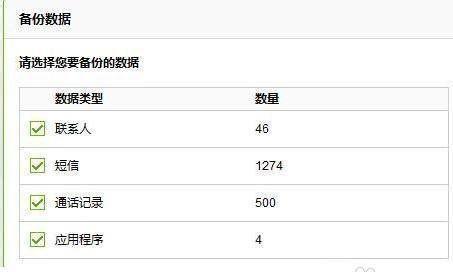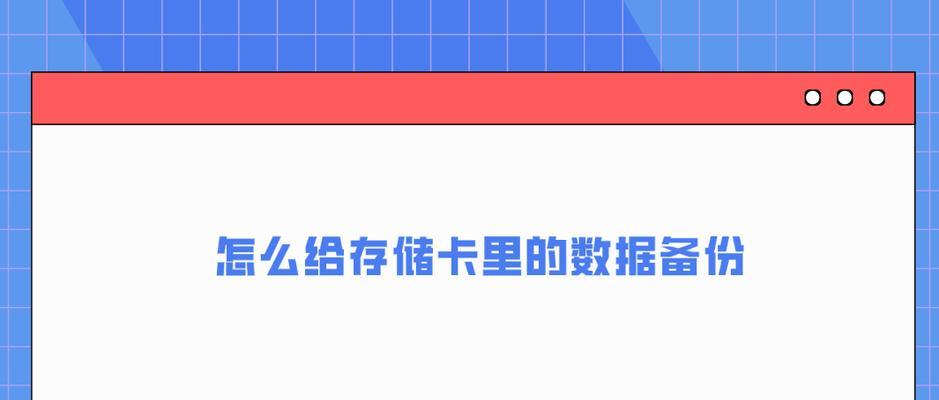 Mobile Tutorial
Mobile Tutorial
 Android Phone
Android Phone
 Recommended software for backing up application data (protect your application data)
Recommended software for backing up application data (protect your application data)
Recommended software for backing up application data (protect your application data)
With the advancement of technology, smartphones and computers have become indispensable tools in our lives. We use them to store photos, videos, manage daily tasks and other important data. However, accidents can always happen, such as operator error, equipment damage or theft. To avoid data loss, regular backup of application data is crucial. To this end, PHP editor Youzi has compiled several excellent backup application data software to help you better protect your valuable data. The following content will provide an in-depth introduction to these software and their features, guiding you to choose the solution that best suits your needs.

1: iCloud Backup (iCloudBackup)
It can automatically back up your iPhone, including apps, text messages, etc., photos, contacts, iCloudBackup is A cloud backup service provided by Apple for all data on your iPad or iPod touch. The device will automatically back up when connected to Wi-Fi, you just need to turn on iCloud Backup-Fi in settings and plug in the charger. This feature is very convenient since you don't need to manually operate or connect to a computer.
2: Google Drive (GoogleDrive)
In addition to storing and sharing files, Google Drive is a cloud storage service provided by Google. It can also back up your mobile application data. Automatically back up application data to the cloud by downloading the GoogleDrive application and logging in to your Google account. Even if your phone is lost or damaged, you can still easily recover app data this way.

3: OneDrive
It can also be used as a tool to back up application data. OneDrive is a cloud storage service provided by Microsoft. To back up app data to the cloud, you can set automatic backup options by downloading the OneDrive app and logging in to your Microsoft account. It is convenient for you to backup data on different devices, and OneDrive can also be synchronized with other devices.
Four: Helium Backup (HeliumBackup)
HeliumBackup is a tool for backing up application data on Android devices. Photos, and supports saving backup files to SD card or cloud storage service. It can back up all data including application data, contacts, etc. Very convenient and easy to use, HeliumBackup also provides backup functions without Root permissions.
5: Titanium Backup (TitaniumBackup)
It requires the device to be Rooted before it can be used normally. TitaniumBackup is another tool for backing up Android application data. Even system applications, you can back up and restore applications and their data through TitaniumBackup. To meet the needs of different users, the tool provides many advanced features such as batch backup and scheduled backup.

6: SuperBackup&Restore
SuperBackup&Restore is a simple and easy-to-use tool for backing up Android device application data. Contacts, call history, etc. It supports backup of application data and can save backup files to SD card or cloud storage service, SMS. To ensure your data is always protected, SuperBackup&Restore can also set up regular backups.
Seven: Dropbox
It can also be used as a tool to back up application data. Dropbox is a well-known cloud storage service provider. To back up application data to the cloud, you can download the Dropbox application and log in to your account. It is convenient for you to share backed up data with others. Dropbox also supports sharing files and folders.
Eight: Local Backup Tools
You can also choose to use local backup tools to protect application data, in addition to cloud backup. Allows you to back up app data to an SD card or computer. Many Android devices come with built-in backup capabilities. And perform manual or automatic backups as needed, you can find these options in the settings.
9: Use third-party backup applications
There are many third-party backup applications to choose from, in addition to the software mentioned above. These apps typically offer more functionality and flexible setup options. BackupYourMobile, etc., AppBackup&Restore, for example. You can choose the software that best suits your backup application data based on your needs.
Ten: Choose the appropriate backup method
You need to consider some factors when choosing software to back up application data, such as data volume, privacy protection and ease of use. However, a certain network connection may be required, and cloud backup usually provides larger storage space and convenient recovery methods. However, you need to manage your own storage devices and perform regular backup operations. Local backup is safer. You can choose the backup method that best suits you based on your needs and circumstances.
11: Check backups regularly
It is very important to check backups regularly, no matter which backup method you choose. But still need to ensure that the backup is successful, you can set the automatic backup option. To protect your data from loss, regular checks can help you detect failed or incomplete backups and take timely action.
Twelve: Multiple backup strategies
Multiple backup strategies are a good choice to better protect your application data. Make sure your data is backed up on different storage devices. You can use both cloud backup and local backup tools. You can still recover data from other backups, even if something goes wrong with one backup, this way.
13: Things to note when restoring application data
You need to pay attention to some things when you need to restore application data. Make sure the backup file you choose is correct and complete. To ensure that the recovery process goes smoothly, follow the recovery guide provided by the software. To avoid data loss or errors, remember to check data integrity after recovery.
Fourteen: The importance of backing up application data
The importance of backing up application data cannot be ignored. Avoid the hassle of data loss or damage, it can help you protect important personal and work data. And check and update backups regularly, choose a backup method that suits you, whether using cloud backup or local backup tools, to ensure that your data is always protected.
Fifteen:
Backing up application data is an important measure to protect personal and work data in the digital age. HeliumBackup, SuperBackup&Restore, OneDrive, including iCloudBackup, we recommend several software for backing up application data, TitaniumBackup, GoogleDrive, Dropbox, etc. You can protect your data from loss by choosing appropriate backup methods and checking backups regularly. Backing up your app data is a critical step in protecting your important data, no matter which backup method you choose.
The above is the detailed content of Recommended software for backing up application data (protect your application data). For more information, please follow other related articles on the PHP Chinese website!

Hot AI Tools

Undresser.AI Undress
AI-powered app for creating realistic nude photos

AI Clothes Remover
Online AI tool for removing clothes from photos.

Undress AI Tool
Undress images for free

Clothoff.io
AI clothes remover

Video Face Swap
Swap faces in any video effortlessly with our completely free AI face swap tool!

Hot Article

Hot Tools

Notepad++7.3.1
Easy-to-use and free code editor

SublimeText3 Chinese version
Chinese version, very easy to use

Zend Studio 13.0.1
Powerful PHP integrated development environment

Dreamweaver CS6
Visual web development tools

SublimeText3 Mac version
God-level code editing software (SublimeText3)

Hot Topics
 Multi-party certification: iPhone 17 standard version will support high refresh rate! For the first time in history!
Apr 13, 2025 pm 11:15 PM
Multi-party certification: iPhone 17 standard version will support high refresh rate! For the first time in history!
Apr 13, 2025 pm 11:15 PM
Apple's iPhone 17 may usher in a major upgrade to cope with the impact of strong competitors such as Huawei and Xiaomi in China. According to the digital blogger @Digital Chat Station, the standard version of iPhone 17 is expected to be equipped with a high refresh rate screen for the first time, significantly improving the user experience. This move marks the fact that Apple has finally delegated high refresh rate technology to the standard version after five years. At present, the iPhone 16 is the only flagship phone with a 60Hz screen in the 6,000 yuan price range, and it seems a bit behind. Although the standard version of the iPhone 17 will have a high refresh rate screen, there are still differences compared to the Pro version, such as the bezel design still does not achieve the ultra-narrow bezel effect of the Pro version. What is more worth noting is that the iPhone 17 Pro series will adopt a brand new and more
 How to update the image of docker
Apr 15, 2025 pm 12:03 PM
How to update the image of docker
Apr 15, 2025 pm 12:03 PM
The steps to update a Docker image are as follows: Pull the latest image tag New image Delete the old image for a specific tag (optional) Restart the container (if needed)
 How to create oracle database How to create oracle database
Apr 11, 2025 pm 02:36 PM
How to create oracle database How to create oracle database
Apr 11, 2025 pm 02:36 PM
To create an Oracle database, the common method is to use the dbca graphical tool. The steps are as follows: 1. Use the dbca tool to set the dbName to specify the database name; 2. Set sysPassword and systemPassword to strong passwords; 3. Set characterSet and nationalCharacterSet to AL32UTF8; 4. Set memorySize and tablespaceSize to adjust according to actual needs; 5. Specify the logFile path. Advanced methods are created manually using SQL commands, but are more complex and prone to errors. Pay attention to password strength, character set selection, tablespace size and memory
 How to delete all data from oracle
Apr 11, 2025 pm 08:36 PM
How to delete all data from oracle
Apr 11, 2025 pm 08:36 PM
Deleting all data in Oracle requires the following steps: 1. Establish a connection; 2. Disable foreign key constraints; 3. Delete table data; 4. Submit transactions; 5. Enable foreign key constraints (optional). Be sure to back up the database before execution to prevent data loss.
 Summary of phpmyadmin vulnerabilities
Apr 10, 2025 pm 10:24 PM
Summary of phpmyadmin vulnerabilities
Apr 10, 2025 pm 10:24 PM
The key to PHPMyAdmin security defense strategy is: 1. Use the latest version of PHPMyAdmin and regularly update PHP and MySQL; 2. Strictly control access rights, use .htaccess or web server access control; 3. Enable strong password and two-factor authentication; 4. Back up the database regularly; 5. Carefully check the configuration files to avoid exposing sensitive information; 6. Use Web Application Firewall (WAF); 7. Carry out security audits. These measures can effectively reduce the security risks caused by PHPMyAdmin due to improper configuration, over-old version or environmental security risks, and ensure the security of the database.
 What are the oracle11g database migration tools?
Apr 11, 2025 pm 03:36 PM
What are the oracle11g database migration tools?
Apr 11, 2025 pm 03:36 PM
How to choose Oracle 11g migration tool? Determine the migration target and determine the tool requirements. Mainstream tool classification: Oracle's own tools (expdp/impdp) third-party tools (GoldenGate, DataStage) cloud platform services (such as AWS, Azure) to select tools that are suitable for project size and complexity. FAQs and Debugging: Network Problems Permissions Data Consistency Issues Insufficient Space Optimization and Best Practices: Parallel Processing Data Compression Incremental Migration Test
 What are the common misunderstandings in CentOS HDFS configuration?
Apr 14, 2025 pm 07:12 PM
What are the common misunderstandings in CentOS HDFS configuration?
Apr 14, 2025 pm 07:12 PM
Common problems and solutions for Hadoop Distributed File System (HDFS) configuration under CentOS When building a HadoopHDFS cluster on CentOS, some common misconfigurations may lead to performance degradation, data loss and even the cluster cannot start. This article summarizes these common problems and their solutions to help you avoid these pitfalls and ensure the stability and efficient operation of your HDFS cluster. Rack-aware configuration error: Problem: Rack-aware information is not configured correctly, resulting in uneven distribution of data block replicas and increasing network load. Solution: Double check the rack-aware configuration in the hdfs-site.xml file and use hdfsdfsadmin-printTopo
 What types of files are composed of oracle databases?
Apr 11, 2025 pm 03:03 PM
What types of files are composed of oracle databases?
Apr 11, 2025 pm 03:03 PM
Oracle database file structure includes: data file: storing actual data. Control file: Record database structure information. Redo log files: record transaction operations to ensure data consistency. Parameter file: Contains database running parameters to optimize performance. Archive log file: Backup redo log file for disaster recovery.





